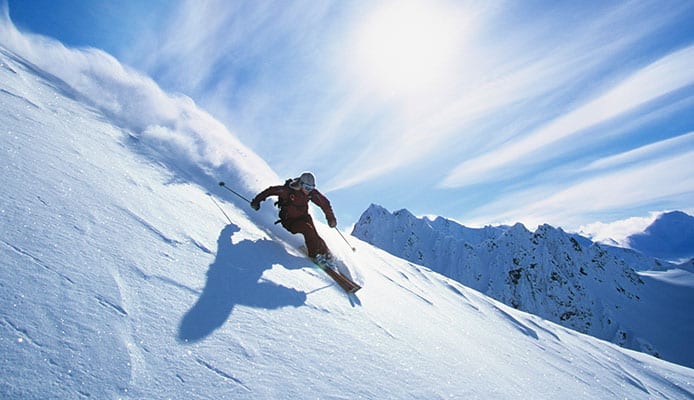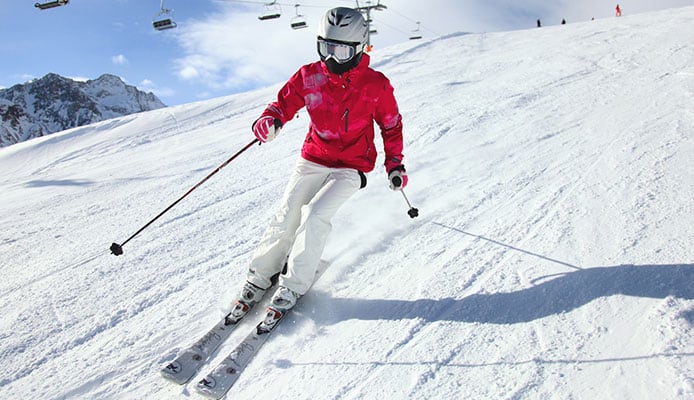
The winter season is here and many skiers just can’t wait to get on those slopes with their skis. However, as much as it is thrilling the last thing you want is to hurl down the steep snowy slopes at an uncontrollable speed. You must know how to ski steep slopes.
One of the most important skills to learn when learning how to ski is stopping on skis. Three main methods are used to stop on skis. These include the pizza, the wedge turn, and the parallel hockey stop.
This is how to stop on skis.
The pizza stop
This method is also known as the snowplow method. It is one of the main skills which a new skier needs to learn.
To perform the snowplow or pizza stop you are going to bring the front of your skis together creating a pizza shape. This is going to slow your speed.
That said when you want to come to a complete stop all you will need to do is to apply much more pressure. The skis will plow into the snow creating friction and allowing you to come to a complete stop.
When practicing the pizza stop for the first time, the first thing that you should do is to get a less steep area and get a friend to pull you. Then, once you begin to gain momentum push out the rear ends of your skis and you should notice yourself begin to slow down.
After you have known how to stop on skis you can move on to learning how to turn on skis.
As you become more and more acquainted with the strategy, then practice digging the edges of the skis into the snow. This increases the friction and will bring you to a complete stop much quicker.
Something to always keep in mind is that you should avoid using your ski poles to stop. Keep practicing on baby slopes and avoid steeper slopes. Until you can perfect the skill, then you can move on to more steeper slopes.
As you perform the plow, you must ensure that your upper body is relaxed.
The wedge turn
This is also known as the snowplow turn. And while it is, in fact, a turn it will still help you come to a stop. As you learn how to stop on skis using the wedge turn, you will follow the same procedure as a pizza by bringing out the rear of the skis. Then to make the turn you will apply more pressure on one leg more than the other.
As you slide down a slope, you will go into a wedge shape. Next, turn one of the skis to the side by applying more weight to it.
To go to the left push onto the right ski and to go to the right, push onto the left ski. As you begin to turn the plan is to come to a stop as the ski faces the side of the mountain.
As you gradually slow down you want to ensure that you apply more weight to the edge of the ski.
Some tips to keep in mind always as you perform the wedge turn is that it will be more comfortable for you to turn on one side more than the other. This is because the body has a dominant side. To protect your knees from the strain you can use the best ski knee braces.
Also, it’s crucial that you maintain your torso in a relaxed state and that you turn your foot every gently. To get better at doing the wedge turn stop, ensure that you practice more often and soon it will come naturally to you.
The parallel stop
It is also known as the hockey stop because it mimics how ice hockey players come to a stop on their skates. Most skiing practice will come down to the parallel stop and it is only reserved for advanced skiers and those who have made good progress on the wedge turn stop. Then later you can learn how to parallel ski.
The parallel stop is an effective technique for stopping on skis. It allows the skier to come to a complete stop when traveling in speed. It will also allow you to change direction quickly when moving fast over the snow. You are better able to change direction and to avoid obstacles ahead of you.
When performing the parallel stop, you want to ensure that you stand up before coming to the stop as this will lift the skis off the snow.
To perform the actual turn, shift your weight to the outside of the downhill ski. Then turn your legs and skis parallel and then begin bending at the knees. Dig into the snow to create friction with both skis on their inner edges and then push through the heels of the ski.
The deeper you dig into the snow the slower you get and the faster you will stop.
Then you want to release the angle of the skis and then flatten them onto the snow to prevent yourself from falling over. It should come as no surprise that you need to be fit and know how to train for skiing.
Then make sure you practice the move regularly to commit it to muscle memory. Once you get good at it, then you will be able to perform the move without thinking.
The importance of learning how to stop when skiing
You must focus on learning how to stop on skis. If you don’t know how to, you can quickly head downhill out of control. This can endanger your life and those of others around you. Granted learning to stop can be tricky but after repeated practice, you will quickly learn how to do the stops the right way.
Learning how to hockey stop can wait until you are more proficient with your wedge turn. Only then can you start practicing the parallel turn.
However, if you have previous experience doing the hockey stop on skates then this should be easy for you to learn the parallel turn.
Never stop with your poles

Many beginner skiers will try to use the poles to stop. This is a bad idea. The poles are not designed for that but should instead be used to push yourself forward and for support. Using the poles to stop can easily bend them, and this can cause you to hurt yourself when moving at high speed.
What you should concentrate on doing is using the poles for support after you have made the stop. Focus on learning the stopping movement first and then use the pole. Take time to learn how to prevent ski and snowboarding injuries.
You might also like: Ski Tricks For Beginners
Riding out the turn
Sometimes you may be going too fast to come to a stop or to employ the wedge turn stop. In this case, you need to figure out a way of slowing down and stopping on skis and this will mainly involve you riding out the turn.
This is a great technique for beginner skiers who are having trouble controlling their speed. It will also help you avoid an obstacle in your path.
Start by placing most of your weight on a single ski and then make the turn. Then keep on skiing instead of linking the turn. And then start to ride uphill. This will slow you down.
It is the gradient of the uphill that will slow you down faster than the snowplow and you will dissipate the momentum by turning uphill.
Note that you also want to avoid facing uphill as this will cause you to slide backward. Instead, look to make a parallel stance and come to a halt.
Falling safely on skis
One of the other main skills that you should aim to learn is how to fall or how to crash. Indeed, it sounds ridiculous. However, if you want to spare yourself months of pain after you’ve broken a collar bone, learning to crash is the way to go.
Take time to learn how to properly kick turn on skis.
You should aim to minimize the impact as you hit the ground. That means spreading out your weight. Compare someone who falls on their side to someone who falls on their elbow. The latter will break your shoulder.
Professional skiers will spend a considerable amount of time learning how to fall. And as a beginner, you can pretty much expect to fall. Some beginners will fall the wrong way and strain a ligament or muscle and even break a bone. Practice ensures you remain safe and that you are ready to try again tomorrow.
While learning how to fall will not take away all of the pain, it will hurt way less than it would if you were to break a body part.
Globo Surf Overview
Two of the most important skills to learn is how to turn on skis and how to fall. After you have gotten the method, it is a practice that will allow you to perfect it.
More Snow Ski Lesson Guides:
- How To Jump On Skis
- What Are Skis Made Of: Ski Construction Guide
- How To Ski While It’s Raining
- 3 Ways How To Carry Skis
- How To Get On And Off Ski Lifts
- How Long Is A Ski Season?
- How Much Does It Cost To Ski
- How To Slow Down Skiing
- How To Ski Rails
- List Of All Types Of Skiing

